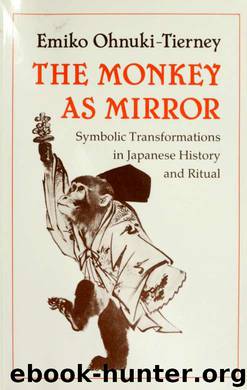The monkey as mirror : symbolic transformations in Japanese history and ritual by Ohnuki-Tierney Emiko

Author:Ohnuki-Tierney, Emiko
Language: eng
Format: epub
Tags: Monkeys, Animals and civilization, Buraku people
Publisher: Princeton : Princeton University Press
Published: 1987-08-05T16:00:00+00:00
REFLEXIVE STRUCTURE OF THE JAPANESE
importance because they indicate that yin always has a yang element, and vice versa. Yin and yang, therefore, represent relative proportions or degrees of significance, rather than yin representing a separate element antagonistic to yang. The two principles are complementary to each other, for neither is meaningful without the other.
Figure 2. A dualistic universe. 131
MEANINGS THROUGH HISTORY
The second important characteristic of this type of dualism is that the universe represents a process or movement in which one principle grows in time into the other, and vice versa. As illustrated in the yin-yang iconography, when the small eye of yang in yin grows large enough, it becomes yang with a small eye of yin in it. The curved dividing line between the two halves of the iconographic image consequently is not a permanent line; rather, it represents a movement.
The resulting universe consists of harmonious complementarity, a state in which neither force asserts absolute hegemony over the other, since the two forces are constantly in gentle motion, gradually changing sides."^ The dualistic principle, such as the yin and the yang, is thus as much a principle of synthesis and an expression of totality as it is a principle for ordering and classifying the universe, which is conceived as an ever-moving process.
To characterize the cosmology of the Japanese throughout history in terms of the yin-yang principle alone may seem to be a sweeping generalization. Indeed, there has been a discernible shift in the basic attitude toward life from the Ancient to the Medieval to the Early Modern to the Modern period. LaFleur, for example, documents that the Medieval cosmology (which he calls "epistome") was characterized by the notions of karma and rokudo transmigration—Buddhistic principles that were unfamiliar to the folk during the Ancient period and have lost their strong hold on people in contemporary Japan (LaFleur 1983:30-31, 59). These Buddhistic principles, however, are basically in accord with the dualism of yin-yang described above. Thus,
■^ Seen in this light, the original Chinese characters liatig-i, which denote dual but not separate meanings, are noteworthy. As Porkert (1974:13) reminds us, liang-i "is used metonymically for t'ien-ti, heaven and earth, i.e., the cosmos. Therefore, yang signifies the beginning, while yin denotes the completion, and a number of paired complementary concepts are expressed hy yin-yang" (Porkert 1974:9^3; see also Granet 1977:48).
Download
This site does not store any files on its server. We only index and link to content provided by other sites. Please contact the content providers to delete copyright contents if any and email us, we'll remove relevant links or contents immediately.
| Anthropology | Archaeology |
| Philosophy | Politics & Government |
| Social Sciences | Sociology |
| Women's Studies |
Mysteries by Colin Wilson(3260)
People of the Earth: An Introduction to World Prehistory by Dr. Brian Fagan & Nadia Durrani(2633)
Ancient Worlds by Michael Scott(2516)
Foreign Devils on the Silk Road: The Search for the Lost Treasures of Central Asia by Peter Hopkirk(2393)
The Memory Code by Lynne Kelly(2289)
The Splendid and the Vile by Erik Larson(2242)
Lost Technologies of Ancient Egypt by Christopher Dunn(2133)
The Earth Chronicles Handbook by Zecharia Sitchin(2113)
Come, Tell Me How You Live by Mallowan Agatha Christie(2039)
The Plantagenets by Dan Jones(1937)
Last Chance to See by Douglas Adams(1857)
The Return of the Gods by Erich von Daniken(1848)
Wars of the Anunnaki by Chris H. Hardy(1636)
Keeper of Genesis by Graham Hancock(1549)
Before the Dawn by Nicholas Wade(1539)
The Cygnus Mystery by Andrew Collins(1479)
The Message of the Sphinx by Graham Hancock(1443)
Fragile Lives by Stephen Westaby(1375)
Hieroglyphs: A Very Short Introduction by Penelope Wilson(1278)
